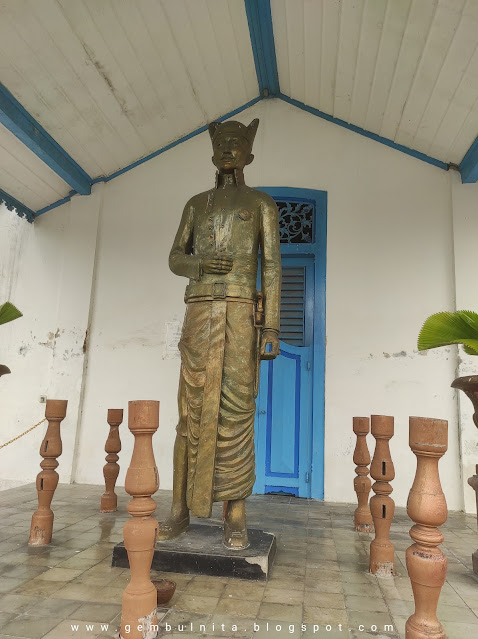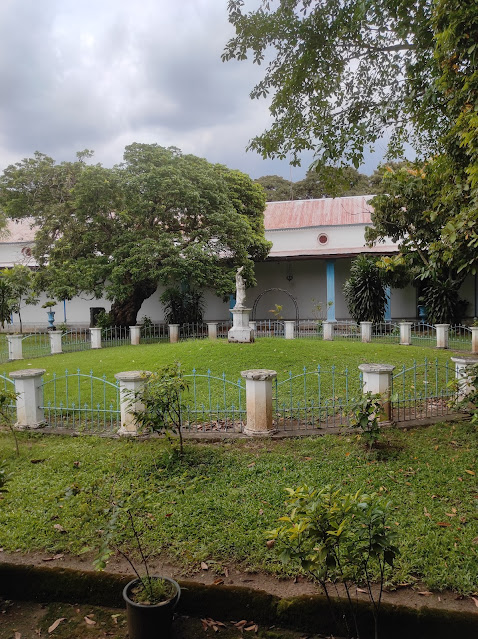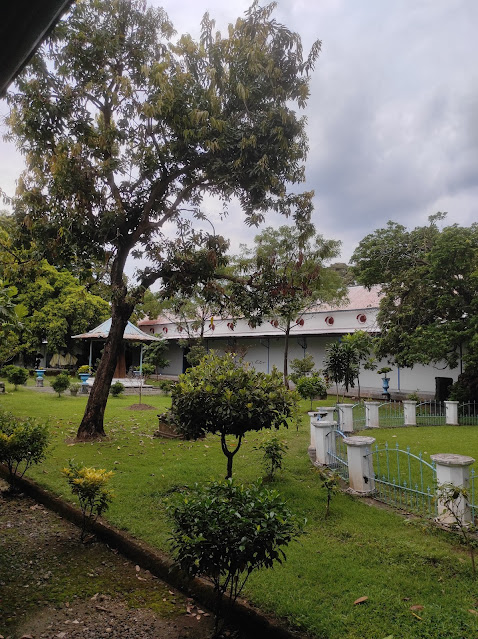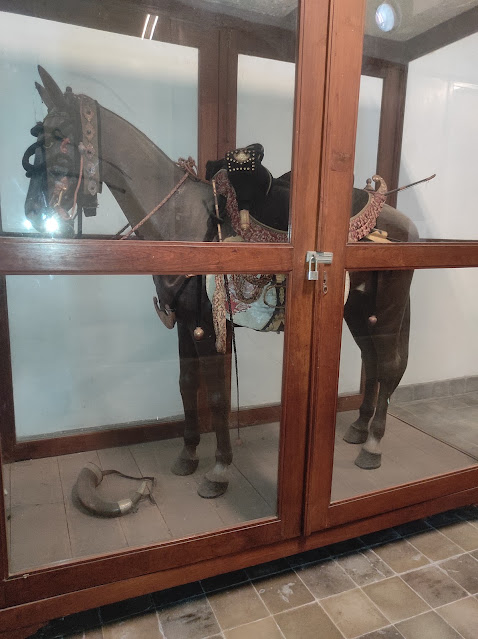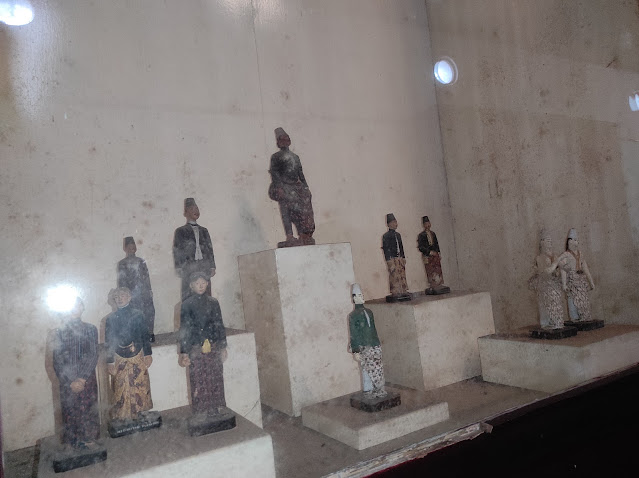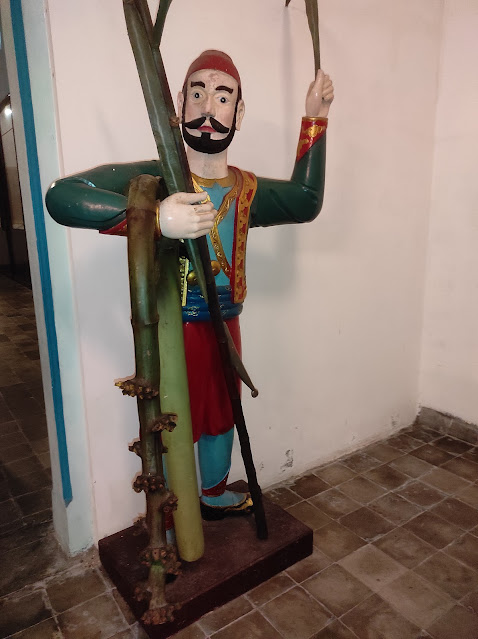Semua foto pada post ini hak cipta milik blog Gembulnita
When we visit to Kasunanan Palace in Surakarta, there are some places that are not allowed to enter like the residence of the King because of Pandemic reason. But we are allowed to enter in public space like museum in Kasunanan area. We bought some tickets for 5 persons (Mbul, Tamas, Mas Montogh, Kakak A, and Uncle Nanang). That has included guide service. There are many collections that make us feel amazed such as royal carriages, ancient weapons, cultural palace, traditional wedding in Surakarta Style, and some other collection. Now, i want describe them by number of pointer, especially the collections by the room.
Room XII
1. Kyai Rojomolo is a giant head statue for boat decoration during the era of King Paku Buwono IV.
2. Small clay sculpture, describe various colors of abdi dalem (servants) of the Palace Soldiers.
3. Ancient ceramics and porcelain that are use to be household and kitchen utensils.
4. The relic steering boat from King Paku Buwono IV sail through the Bengawan Solo River.
5. Kitchen tools
6. Pipisan is our equipment used to refine seeds and herbs
cething is a kitchen tools used a place to put cooked rice and ready to be served
7. Traditional games include dakon (congklak), tools for crickets fight, cock-fight and candle
8. Gledek a container for cuttery utensils.
9. Keraton rooftop made of teak wood.
10. Dandang (traditional rice cooker), a tool for cooking rice for war purposes
11. Lesung is traditional tool in processing rice/grains into rice.
12. Lumpang is a container made of wood or stone to pound rice, coffee, or other processed material.
Room XI
1. There are ancient weapons, such as buns, pistols, swords, shieds, keris, arrows, and horse saddles.
2. Pareanom bridal umbrellas with specific colors, green and yellow symbolized prosperity and fertility.
3. Diorama of war scene between Prince Diponegoro and Dutch Company in Selarong Cave (1825-1830)
"Mbul sampai terkesan melihat diorama perjuangan Pangeran Diponegoro dibantu oleh Sentot Alibasyah Prawirodirjo, Kyai Mojo dan para prajurit melawan penjajahan Belanda di Goa Selarong, lereng Gunung Merapi-Merbabu"
Room IX
1. Kyai Groedo carriage from the age of Sinuhun Pakubuwono II in Kartasura VOC offerings (1745)
2. Kyai Morosebo carriage Royal Chariots were the era of Pakubuwono VII to Pakubuwono X to pick the great guest (1770)
3. Raja PB II and his queen's paintings. Her queen painting is a 3D painting, so it can be seem from all dorections. It observed carefully into her eyes.
4. Fossil of Kyai Slamet or albino buffalo which is used for heirloom of Islamic Year eve (1 Suro) arround the Surakarta Pallace.
5. A cupboard containing a uniform of cabby and horse saddles.
Room VI
1. In this room, various ceremonial instrument objects are exhibited, including :
- Bokor is a water container
- Kendi Pratolo is a water container shaped like a teapot made of clay
- Beri is a tray to carrying beverage to guest
- Kecohan is a place to dispose saliva after eating the battle leaf
2. Jewelry such as ring earring, bracelet, nackle
3. Three tiered King umbrella for circumtance ceremony Pakubuwono IV
4. A picture of KGPA Panembahan Djati Kusumo
5. A picture of Gusti Kanjeng Ratu Ageng Permaisuri PB X (left)
7. A Picture of King Paku Buwono XI grandmother (right)
Room VI
1. Wayang Baber is a puppet art that emerged and developed in Java in pre Islamic era.
2. Gamelan (gamel) means that act of drumming of hitting. In Indonesia, gamelan usually accompanies dance, wayang puppet performances, or ritual and ceremonies.
3. Gong Kyai Rendeng relic of King Paku Buwono IX for start archery practice
4. Jaran kepang is a dance that describe war soldiers riding on the horse. The story of the warrior refers to the epic of the prince Diponegoro when fighting againts the Dutch army
5. Topeng dance is a dance to welcoming the Keraton's guests, and it was used as a way of spreading Islam at the same time use a show in the palace environment.
-Lengger mask dance is a paired dance, telling the love story between Galuh Candra Kirana and Panji Asmoro Bangun. This dance was created by Sunan Kalijaga, he used this dance a means of spreading Islam.
6. Tayuban dance is one of the traditional arts of central Java. When dancing a tayub dance, the female dancer called "ledhek" invites a male dance by draping a scraf called "sampur" and female dancer are often given money.
7. Sodoran is a war game with horsemen and armed with "sodor". Sodor is a long woodeng spear (bamboo, etc) with blunt edges.
8. Rebab Gading is an instrument made of elepants gading cow's, skin, and horse's tail.
Room V
1. Diorama of Wayang exhibition (traditional art puppet) a person who plays wayang are called Dalang. A Dalang must be able to imitate 100 puppet sounds which one held with the right side is a good character and the left side is a bad character.
2. Wayang Suket is made of grass stalks that have been dried then woven.
3. Wayang golek menak tell about the entry of Islam through the trade roote.
4. Wayang gedog taken from the word gedhogan, which means horse stable
5. Wayang klitik has meaning tiny, tells the story of Damarwulan
6. Relief of wayang kulit exhibition
7. a relief of gamelan exhibition
Room III
1. Replica of the horse and saddle use for the groom's carnival
2. Panggih ceremony is held after the bride becomes a legitimate husband ans wife and meets at the wedding chair
3. Handover sanggan and balang gantal. The grooms hand the banana to the mother of the bride
4. Midak tigan procession, stepping on chicken eggs carried by the groom
5. Sinduran is procession of wrapping, cloth on the bride and groom shoulder. The red cloth is the symbol of women while white is the symbol of men. In the procession of bobot timbang, the bride sits on the bride's father's lap on the left thigh and the man on the right thigh, then weighs the heavier one.
7. Kacar-kucur ritual, this ritual means that the groom is willing to be responsible for providing the family needs, while the wife should use it wisely.
8. Dahar klimah, the bride and groom feed each other
9. Kirab, is a procession to bring the bride and groom to the altar
Room 1
1. A photo of children's King Paku Buwono XII
2. A photo of King Paku Buwono IX
3. A photo of King Paku Buwono XII
4. Hat relic of King Paku Buwono X
5. Painting of Paku Buwono X, sitting with king's clothes
6. Painting of King Paku Buwono VI-X
7. Painting Of Gusti Kanjeng Ratu Hemas, The Second Queen of King Paku Buwono X
8. Several carved chair from King Paku Buwono IV era (1788-1820)
9. Two carved chairs from Gianyar Palace (Bali) for King Paku Buwono X
10. A carved chair, a seat for King Paku Buwono X
11. Two carved cabinets from King Paku Buwono X era.
12. Kuluk Mathak Keris is a headgear. It is characteristic of javanese bride. The educational value of Kuluk Mathak responsibility means responsibility husband as head of the family.
13. Songkok (Indonesia's traditional hat) of King Paku Buwono VI, VII, and X
14. Sarajantara is a spear shielded from King Pakubuwono IX
We are very happy and it will be a best experience to know Surakarta Hadiningrat Palace Museum. Hopefully, someday, we can visit back again and explore many things. See you...blog gembulnita, www.gembulnita.blogspot.com)





